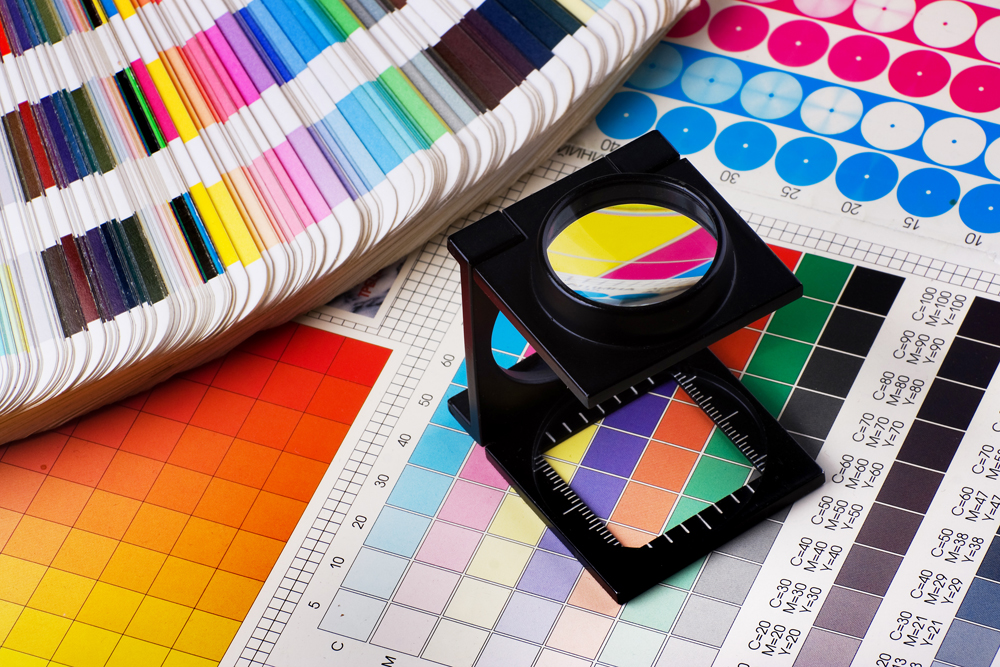The purpose of proofing a print job is to create a contract between the printer and the customer. It’s an agreement that the printer will deliver to the customer exactly what is expected. Content, color, and quality are agreed upon and upheld.
A proof proves to the customer that the printer’s process can produce the materials that are ordered.

The Way We Used to Do It
Historically the proofing process has been a manually output, physical representation of the printed piece. There were drawbacks in the time it took to create a proof.
As far as production processes go, and by today’s standards, a contract proof was relatively downstream. That means if changes to the content were required, producing another proof pulls the job back several stages in production.
Running a press used to be a craft with learned nuances that couldn’t necessarily be taught. An experienced, talented pressman could be relied upon to match a proof. The color would be accurate and consistent from the first saved impressions to the end of the run.
Technology has come a long way with both color systems on presses and plating software.
Having ink key settings sent to the press for each plate extremely improves make-ready and the number of impressions to start saving sheets. Advanced press controls with precise quality systems translate into far more efficient results when training new press operators. Matching a proof became more objective than subjective.
As far as proofing time is concerned, the late 1940s saw the introduction of the first overlay system, GAF Ozachrome. In 1965, 3M Color Key debuted, while the 1970s saw 3M technology become Kodak Match Print and the introduction of Dupont Cromalin.
Iris inkjet made an impression in 1987 followed by dye sublimation and laser sublimation in the 1990s. Soft proofing emerged in 2003, and in 2005, the first spectrophotometers were integrated with inkjet printers.
In 2010, the majority of hard proofs were being produced on an inkjet.
How Print Proofing is Done Today
The printing industry threw up its collective hands when PDF technology first crept into its world. “There is no way that will ever work for a quality print job!” they exclaimed.
In the same vein, the idea of approving a job on-screen instead of by hard proof just seemed ludicrous. Soft proofing by email or Web site took some time to take hold as an acceptable contract proof.
The accuracy of soft proofing has greatly improved in recent years. It’s become a typical, expected, and desirable way to approve a print job.
Color-calibrated monitors are a requirement for accurately assessing a soft proof.
However there is a great distance between what customers and designers are seeing versus what printers are seeing either in prepress or at a press-side viewing screen. Aligning these assorted devices is what color profiles are for, but there are shortcomings in the implementation.
Verifying content is quite simple via soft proof, but without a hard proof, there needs to be some contractually definitive way to approve color.
An agreement on CMYK mix and specifying PANTONE® color are two places to start.
When color is critical for continuous tone images, the best way to ensure accuracy is providing a hard proof. With the quality of modern digital presses, it’s possible to run only two or three sheets and present those to the customer as a proof.
The time it takes to get files into a print shop and on press is mere minutes. Automation combined with digital press technology facilitates the plausibility of press sheets used as contract proofs regarding time, cost, and convenience. It also provides customers with proof of the process.
Soft Proofing Methods
The common methods of soft proofing used today boil down to sending PDF files by email or serving up a print job rendered in a Web portal.
There are disadvantages to both. For instance, neither method ensures color management from file design to proof viewing. Even with adherence to ICC profiles and device calibration, viewing environments and rendering engine variances do not guarantee color accuracy.
As technology progresses, this final hurdle will eventually be overcome.
Sending a PDF by email can be the easiest way to get proofs to customers, since no additional software is required by the printer or the customer.
Emailing PDFs as a soft proof does have some caveats. File sizes can lead to issues with attachments. Prepress technicians reduce or optimize the production PDF using various software.
Adobe Acrobat Pro has a feature to perform file size reduction. Viewing PDF files happens on a wide array of devices, software and render engines. There is no way to ensure that prepress departments are seeing the same content on screen as the customer.
Transparency can be one of the biggest uncertainties, leading to unexpected content in the printed piece.
Transparency Issues Caused by White Overprint
Online soft proofing requires the printer to integrate and maintain a method of providing that service. The cost of such a service is relatively low, and it is convenient to customers.
The use of a Web portal to provide soft proofs can also have a downside. Managing users, administering the system, and seamless integration with production systems contribute to overhead. As with an emailed PDF, the file being viewed is likely not the one that will be sent to press.
Acceleration Due to a Pandemic
The need for digital proofing techniques has been increasing, and it shouldn’t be a surprise that the pandemic has proven to be a major accelerator to this trend. On-premises visits are pretty much taboo, and processes, including print, went digital at warp speed.
There are many advantages to digital proofing nowadays:
- Relieves production staff from manually creating and sending PDF proofs;
- Speeds up the response time from file received to proof ready;
- Approvals go straight to production;
- Customer inspects the production PDF file;
- Inspection tools can be customized;
- Removes the uncertainty of customer viewing methods; and
- The interface can be branded to your business.
Of course, the above is all reliant on if you are able to implement it correctly.
Be sure to find an online proofing system that integrates with web-to-print, MIS, and production. A software investment is typically a fraction of a new piece of equipment.
So with that in mind, what are you waiting for?
By Andrew Bailes-Collins, senior product manager at PDF preflight and automation software technology developer Enfocus.










